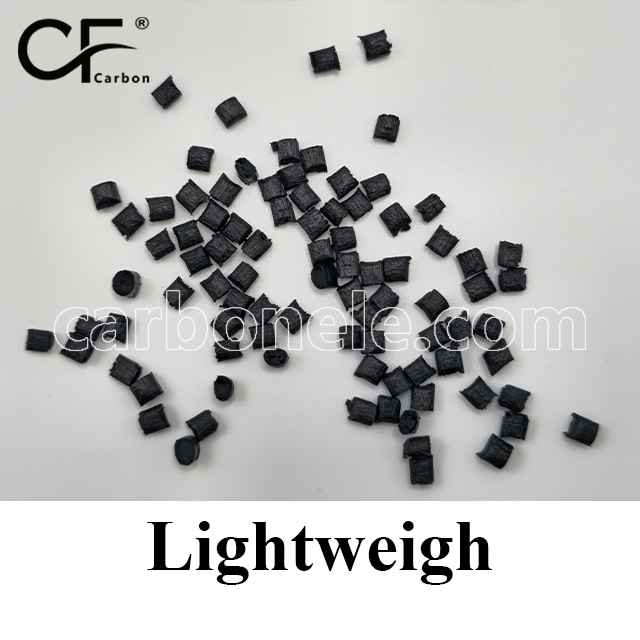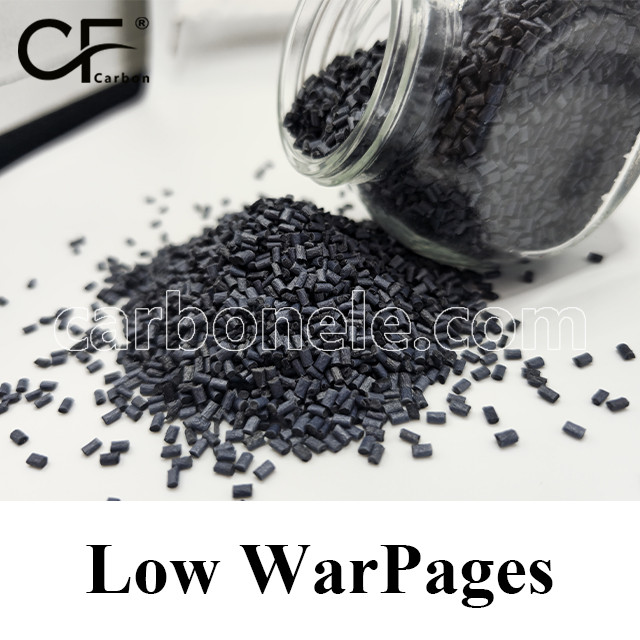
Outstanding Performance &Versatile Applications of CFRTPs
Short CF Thermoplastic Composites, or chopped carbon fiber thermoplastic composites, have the following performance characteristics: 1. High strength and stiffness: The incorporation of chopped carbon fibers greatly improves the mechanical properties of the thermoplastic matrix, making them suitable for applications demanding strong structural support. 2. Excellent fatigue resistance: They can endure repeated loading and unloading without significant performance deterioration, essential for components under cyclic stresses. 3. Good impact resistance: The combination of carbon fibers and the thermoplastic matrix enables absorption and dissipation of energy upon impact, lowering the risk of failure. 4. Good thermal stability: They can retain their mechanical properties at high temperatures, suitable for applications in high-heat environments. 5. Enhanced dimensional stability: They have low shrinkage and warpage during processing and in-service, ensuring consistent and precise part dimensions. 6. Lightweight: Compared to traditional metal materials, they provide comparable or superior mechanical performance while being lightweight, beneficial in weight-sensitive applications like aerospace and automotive.
Applications in various fields: 1. Aerospace Industry: They are used in aircraft components such as wing structures, fairings, and interior parts where high strength-to-weight ratio and durability are crucial. 2. Automotive Sector: Applied in car bodies, chassis, and engine components to reduce weight and improve fuel efficiency while maintaining structural integrity. 3. Electronics: Utilized in manufacturing lightweight and durable casings for electronic devices. 4. Sports Equipment: Found in the production of high-performance sports gear like bicycle frames, tennis rackets, and golf clubs. 5. Medical Devices: Used for creating lightweight and strong prosthetics and medical equipment. 6. Industrial Machinery: Incorporated into parts of industrial machinery where resistance to wear and high mechanical strength are required. 7. Consumer Goods: Can be seen in products like luggage and furniture for enhanced durability and lightweight design.
Product By Features

PBT-CF05 Carbon Fiber Reinforced Polypropylene
PBT-CF05 is a polybutylene terephthalate (PBT) reinforced with 5% carbon fiber, offering improved stiffness and strength for moderate mechanical loads. It performs well in temperatures up to 210°C and resists a variety of chemicals. Ideal for automotive, industrial, electronics, and household applications, it is processable via injection molding and extrusion.
Learn More
Mechanical Properties PEI-CF60
PEI-CF60 is a high performance thermoplastic reinforced with 60% carbon fiber, offering exceptional stiffness, strength, and wear resistance. With excellent thermal and chemical resistance, it excels in extreme, high-stress environments. Ideal for aerospace, automotive, electronics, and industrial applications, PEI-CF60 provides superior durability while remaining easy to process through injection molding…
Learn More
Carbon Fiber Reinforced Plastic PEI-CF50
PEI-CF50 is a high performance thermoplastic reinforced with 50% carbon fiber, offering exceptional stiffness, strength, and wear resistance. With outstanding thermal and chemical resistance, it excels in extreme, high-stress environments. Ideal for aerospace, automotive, electronics, and industrial applications, PEI-CF50 provides excellent durability while remaining processable via injection molding and extrusion.
Learn More
PEI-CF40 Carbon Fiber Reinforced Plastic
PEI-CF40 is a high performance thermoplastic reinforced with 40% carbon fiber, offering exceptional strength, wear resistance, and chemical stability. Ideal for extreme, high-stress environments, it performs well in aerospace, automotive, and electronics applications. It also boasts excellent thermal resistance and low moisture absorption, with easy processing via injection molding and…
Learn More
PEI-CF30 Unrivaled Strength Longevity
PEI-CF30 is a high-performance thermoplastic reinforced with 30% carbon fiber, offering exceptional strength, stiffness, wear resistance, and thermal stability. Ideal for extreme-duty applications in automotive, aerospace, and medical devices, it excels in environments with high mechanical loads, temperatures, and chemical exposure while maintaining excellent dimensional stability.
Learn More
High Wear Resistance CF30 PPS Pellets for Rack ...
High Wear Resistance CF30 PPS Pellets are a high-performance composite materi...
Learn More
Unrivaled Strength Longevity PEI-CF20
PEI-CF20 is a high-performance thermoplastic reinforced with 20% carbon fiber, offering exceptional strength, stiffness, and wear resistance. It maintains excellent thermal and chemical properties, making it ideal for demanding applications in automotive, aerospace, and medical devices where high mechanical loads, extreme temperatures, and chemical exposure are involved.
Learn More
PEI-CF05 Maximum Strength Endurance
PEI-CF05 is a high-performance thermoplastic reinforced with 5% carbon fiber, offering balanced mechanical strength, enhanced wear resistance, and excellent thermal and chemical stability. It is ideal for moderate-duty applications in automotive, aerospace, and industrial sectors, where reliable performance under moderate temperatures and chemical exposure is required. PEI-CF05 maintains low moisture…
Learn More
PEEK-CF05 Premium Performance Polymer
PEEK-CF05 is a 5% carbon fiber-reinforced engineering plastic offering enhanced strength, stiffness, and wear resistance compared to pure PEEK. It provides excellent thermal stability, chemical resistance, and dimensional stability, making it ideal for applications in automotive, electronics, and industrial manufacturing under moderate mechanical loads and high temperatures.
Learn More
Virgin Polypropylene PP CF30 Raw Materials for ...
PP CF30 Raw Materials are reinforced polypropylene materials with 30% carbon fiber, offering high rigidity, strength, and wear resistance, along with conductive properties and good thermal stability, suitable for applications in packaging, electronics, and mechanical components.
Learn More
Carbon Fiber Copolymer Polypropylene CF30 PP Ra...
Carbon Fiber Copolymer Polypropylene CF30 PP has features like high tensile strength, good rigidity, suitable heat distortion temp., low linear expansion, moderate density, corrosion resistance and easy processability for various applications.
Learn More
Homo Polypropylene Carbon Fiber PPH CF40 Raw Ma...
Homo Polypropylene Carbon Fiber PPH CF40 has high tensile strength, good rigidity, thermal stability, low water absorption, insulation, corrosion resistance, good fluidity, and smooth product surface, with proper density and appearance.
Learn MoreProduct Feature Box

WEAR RESISTANCE

CONDUCTIVE MATERIALS

HIGH STRENGTH

ANTI STATIC

SCRATCH RESISTANCE

ABRASION RESISTANCE

ECO FRIENDLY

LIGHT WEIGHT
Characteristics of Short CF Thermoplastics
1. High strength
It has excellent tensile and bending strength and can withstand large external forces. It can enhance the stability of the structure and improve collision safety.
2. High modulus
It has a high elastic modulus and good rigidity. In the aerospace field, it helps to reduce weight while ensuring the shape stability of components.
3. Lightweight
It is lighter, which helps to reduce the weight of the overall structure. Applied in sports equipment, such as bicycle frames, it makes it easier for athletes to control.
4. Fatigue resistance
It can withstand repeated loads and stresses without being easily damaged. In mechanical transmission components, it prolongs the service life.
5. Good corrosion resistance
It has a high resistance to chemical substances and environmental factors. Suitable for chemical equipment to reduce damage caused by corrosion.
6. Excellent heat resistance
It can still maintain its performance in high-temperature environments. It can be used in high-temperature working scenarios such as engine components.
7. Good electrical conductivity
It performs well in some applications that require electrical conductivity. For example, the shell of electronic equipment.
8. Easy processing and molding
It can be manufactured through various processes such as injection molding and extrusion. To meet the needs of different shapes and sizes.
9. Recyclability
It has the characteristic of recyclability and reuse, which is in line with environmental protection requirements. It helps to reduce the generation of waste.
Company Advantage

MODERN FACTORY
Carbon (Xiamen) New Material Co., Ltd., a shining pearl in the field of carbon fiber modified materials, is driven by technological innovation and has distinct product characteristics: light weight, high strength, excellent performance; customized production, flexible to meet diverse needs; environmentally friendly technology, leading the trend of green manufacturing. Modern production lines ensure high efficiency and stability, and are the trusted choice of the industry.

KEY LABORATORY
R&D laboratories, the cradle of technological innovation, gather top talents and precision equipment. Here, every fantastic idea is carefully nurtured, and through countless experiments and tests, theories are transformed into practical applications. In the brightly lit space, researchers are exploring the unknown day and night, promoting technological progress, and bringing disruptive solutions to society.
Frequently Asked Questions
Carbon (Xiamen) New Material Co., Ltd. aims to provide buyers with "one-stop" worry-free high-quality services. Here you can find all information about carbon fiber engineering plastics. If you still have questions, please send us an email for consultation!
-
1: What is the main advantage of Chopped CF Thermoplastic Composites over traditional materials?
Chopped CF Thermoplastic Composites offer a combination of high strength, lightweight, and good resistance to fatigue and impact. They are also easier to process and recycle compared to some traditional materials.
-
2: How does the cost of Chopped CF Thermoplastic Composites compare to other composites?
The cost can vary depending on factors such as the quality and quantity of carbon fibers used. Generally, they may be more expensive than some common composites initially, but their superior performance and potential for reduced manufacturing costs in the long run can offset the higher upfront expense.
-
3: Can Chopped CF Thermoplastic Composites be used in extreme temperature environments?
They have good thermal stability and can perform well in a wide range of temperatures. However, the specific temperature limits depend on the type of thermoplastic matrix and the amount of carbon fiber reinforcement.
-
4: Are Chopped CF Thermoplastic Composites electrically conductive?
Yes, they can have some level of electrical conductivity depending on the composition and arrangement of the carbon fibers.
-
5: How difficult is it to machine Chopped CF Thermoplastic Composites?
Machining can be challenging due to their high strength and hardness. Specialized tools and techniques are often required, but advancements in processing methods are making it more manageable.
-
6: Do Chopped CF Thermoplastic Composites have any environmental benefits?
They are more recyclable than many other composite materials, reducing waste and the environmental impact. Also, their lightweight nature leads to lower energy consumption during transportation.
-
7: What types of bonding methods are suitable for joining parts made of Chopped CF Thermoplastic Composites?
Adhesive bonding, welding, and mechanical fastening methods can be used. The choice depends on the specific application and design requirements.
-
8: Can Chopped CF Thermoplastic Composites be colored?
Yes, they can be colored using specialized dyes or coatings without significantly affecting their properties.
-
9: How long is the lifespan of products made from Chopped CF Thermoplastic Composites?
With proper design and maintenance, they can have a long lifespan, often outlasting similar products made from traditional materials.
-
10: Are there any limitations to the size and shape of components that can be made from Chopped CF Thermoplastic Composites?
While they offer considerable design flexibility, very large or complex shapes may pose manufacturing challenges. However, continuous advancements in processing technologies are expanding the possibilities.
-
11: Which do common representatives of Chopped CF Thermoplastic Composites include?
1. Carbon Fiber Reinforced Polyamide (CFPA) has good mechanical, heat and chemical stability. 2. Carbon Fiber Reinforced Polyester (CFPET) has decent wear, heat and chemical resistance. 3. Carbon Fiber Reinforced Polyimide (CFPI) composites are high-performance prepreg tapes due to polyimide's high heat and chemical resistance. 4. Carbon Fiber Reinforced Polycarbonate (CFPC) has excellent mechanical, heat and corrosion resistance, used in high-performance manufacturing. 5. Continuous Fiber Reinforced Polyphenylene Sulfide (PPS-CF/UD), made by melt impregnation, has multiple advantages and is used in automotive, aerospace, etc. for various parts.










